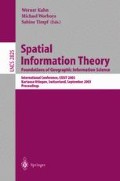Abstract
Spatializations are computer visualizations in which nonspatial information is depicted spatially. Spatializations of large databases commonly use distance as a metaphor to depict semantic (nonspatial) similarities among data items. By analogy to the “first law of geography”, which states that closer things tend to be more similar, we propose a “first law of cognitive geography,” which states that people believe closer things are more similar. In this paper, we present two experiments that investigate the validity of the first law of cognitive geography as applied to the interpretation of “point-display spatializations.” Point displays depict documents (or other information-bearing entities) as 2- or 3-dimensional collections of points. Our results largely support the first law of cognitive geography and enrich it by identifying different types of distance that may be metaphorically related to similarity. We also identify characteristics of point displays other than distance relationships that influence similarity judgments.
Access this chapter
Tax calculation will be finalised at checkout
Purchases are for personal use only
Preview
Unable to display preview. Download preview PDF.
References
International Cartographic Association (ed.): Multilingual Dictionary of Technical Terms in Cartography. ICA, Stuttgart (1973)
Card, S.K., Mackinlay, J.D., Shneiderman, B.: Readings in Information Visualization: Using Vision to Think. Morgan Kaufmann, San Francisco (1999)
Spence, R.: Information Visualization. Addison Wesley, Boston (2001)
Fabrikant, S.I.: Evaluating the Usability of the Scale Metaphor for Querying Semantic Spaces. In: Montello, D.R. (ed.) COSIT 2001. LNCS, vol. 2205, pp. 156–172. Springer, Heidelberg (2001)
MacEachren, A.M.: How Maps Work: Representation, Visualization, and Design. Guilford Press, New York (1995)
Slocum, T.A., Blok, C., Jiang, B., Koussoulakou, A., Montello, D.R., Fuhrmann, S., Hedley, N.R.: Cognitive and Usability Issues in Geovisualization. Cart. & Geog. Infor. Sci. 28, 61–75 (2001)
Couclelis, H.: Worlds of Information: The Geographic Metaphor in the Visualization of Complex Information. Cart. & Geog. Infor. Sys. 25, 209–220 (1998)
Kuhn, W., Blumenthal, B.: Spatialization: Spatial Metaphors for User Interfaces. Depart. Geoinfor. Tech. Univ. Vienna (1996)
Fabrikant, S.I., Buttenfield, B.P.: Formalizing Semantic Spaces For Information Access. Annals Assoc. Amer. Geog. 91, 263–280 (2001)
Shepard, R.N.: Representation of Structure in Similarity Data—Problems and Prospects. Psychometrika 39, 373–422 (1974)
Skupin, A.: From Metaphor to Method: Cartographic Perspectives on Information Visualization. In: IEEE Symposium on Information Visualization, InfoVis 2000, Salt Lake City, UT, pp. 91–97 (2000)
Tobler, W.R.: A Computer Movie Simulating Urban Growth in the Detroit Region. Econ. Geog. 46, 234–240 (1970)
Fabrikant, S.I.: Spatial Metaphors for Browsing Large Data Archives. Unpublished Ph.D. Diss., Depart. Geog., Univ. Colorado-Boulder (2000)
Chalmers, M.: Using a Landscape Metaphor to Represent a Corpus of Documents. In: Campari, I., Frank, A.U. (eds.) COSIT 1993. LNCS, vol. 716, pp. 377–390. Springer, Heidelberg (1993)
Wise, T.A.: The Ecological Approach to Text Visualization. J. Amer. Soc. Infor. Sci. 53, 1224–1233 (1999)
Dieberger, A., Frank, A.U.: A City Metaphor for Supporting Navigation in Complex Information Spaces. J. Visual Lang. Comp. 9, 597–622 (1998)
Berendt, B., Jansen-Osmann, P.: Feature Accumulation and Route Structuring in Distance Estimations - An Interdisciplinary Approach. In: Frank, A.U. (ed.) COSIT 1997. LNCS, vol. 1329, pp. 279–296. Springer, Heidelberg (1997)
Hartley, A.A.: Mental Measurement in the Magnitude Estimation of Length. J. Exp. Psych.: Human Perc. Perf. 3, 622–628 (1977)
Montello, D.R.: The Perception and Cognition of Environmental Distance: Direct Sources of Information. In: Frank, A.U. (ed.) COSIT 1997. LNCS, vol. 1329, pp. 297–311. Springer, Heidelberg (1997)
Goldstone, R.L.: Similarity, Interactive Activation, and Mapping. J. Exp. Psych.: Learn., Mem., Cog. 20, 3–28 (1994)
Medin, D.L., Goldstone, R.L., Gentner, D.: Respects for Similarity. Psych. Rev. 100, 254–278 (1993)
Tversky, A.: Features of Similarity. Psych. Rev. 84, 327–352 (1977)
Buffardi, L.: Factors Affecting the Filled-Duration Illusion in the Auditory, Tactual, and Visual Modalities. Perc. & Psychophys. 10, 292–294 (1971)
Thorndyke, P.W.: Distance Estimation from Cognitive Maps. Cog. Psych. 13, 526– 550 (1981)
Amstrong, L., Marks, L.E.: Differential Effects of Stimulus Context on Perceived Length: Implications for the Horizontal-Vertical Illusion. Perc. & Psychophys. 59, 1200–1213 (1997)
Gregory, R.L.: Eye and Brain: The Psychology of Seeing, 3rd edn. McGraw-Hill, New York (1978)
Goldstein, E.B.: Sensation and Perception, 3rd edn. Wadsworth, Belmont (1989)
Gregory, R.L. (ed.): The Oxford Companion to the Mind. Oxford University Press, Oxford (1987)
Cohen, J., Cohen, P.: Applied Multiple Regression/Correlation Analysis for the Behavioral Sciences. Lawrence Erlbaum Ass., Hillsdale (1975)
Montello, D.R.: Scale and Multiple Psychologies of Space. In: Campari, I., Frank, A.U. (eds.) COSIT 1993. LNCS, vol. 716, pp. 312–321. Springer, Heidelberg (1993)
Masin, S.C.: Absolute and Relative Effects of Similarity and Distance on Grouping. Perc. 31, 799–811 (2002)
Friedman, A., Brown, N.R.: Reasoning about Geography. J. Exper. Psych.: Gen. 129, 193–219 (2000)
Hirtle, S.C., Jonides, J.: Evidence of Hierarchies in Cognitive Maps. Mem. & Cog. 13, 208–217 (1985)
Huttenlocher, J., Hedges, L.V., Duncan, S.: Categories and Particulars: Prototype Effects in Estimating Spatial Location. Psych. Rev. 98, 352–376 (1991)
Author information
Authors and Affiliations
Editor information
Editors and Affiliations
Rights and permissions
Copyright information
© 2003 Springer-Verlag Berlin Heidelberg
About this paper
Cite this paper
Montello, D.R., Fabrikant, S.I., Ruocco, M., Middleton, R.S. (2003). Testing the First Law of Cognitive Geography on Point-Display Spatializations. In: Kuhn, W., Worboys, M.F., Timpf, S. (eds) Spatial Information Theory. Foundations of Geographic Information Science. COSIT 2003. Lecture Notes in Computer Science, vol 2825. Springer, Berlin, Heidelberg. https://doi.org/10.1007/978-3-540-39923-0_21
Download citation
DOI: https://doi.org/10.1007/978-3-540-39923-0_21
Publisher Name: Springer, Berlin, Heidelberg
Print ISBN: 978-3-540-20148-9
Online ISBN: 978-3-540-39923-0
eBook Packages: Springer Book Archive

